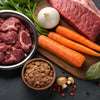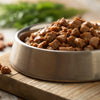Is Raw Dog Food Worth It? A Comprehensive Look at Benefits and Risks
- Houndsy
Table of Contents
- Introduction
- Understanding Raw Dog Food
- Potential Benefits of Raw Dog Food
- Potential Risks of Raw Dog Food
- Research Insights and Veterinary Guidance
- Making the Decision: Is Raw Dog Food Worth It?
- Conclusion
Introduction
As pet owners, we all strive to provide our beloved companions with the best nutrition possible. Just like any concerned parent, we find ourselves exploring various feeding options to ensure our furry friends thrive. A compelling statistic shows that raw pet food sales have surged, increasing by an astounding 15% annually. This raises an important question: is raw dog food worth it?
In recent years, many dog parents have turned to raw dog food diets, drawn by promises of healthier coats, improved energy, and cleaner teeth. However, this interest represents both a trend and a profound shift in how we think about pet nutrition. This blog post seeks to explore the multifaceted world of raw dog food, discussing its potential benefits and drawbacks to help you make an informed decision about your own pet’s diet. By the end of this article, you will not only understand the raw dog food landscape but also be equipped with practical advice on how to navigate your pet’s feeding routine effectively.
As we delve into the various aspects of raw dog food, we invite you to reflect on your own pet feeding practices and consider whether a raw diet might fit into your dog's nutritional plan. Our main takeaway? While there's potential upside to raw dog food, the decision must be weighed carefully against individual pet needs, health considerations, and possible risks.
Understanding Raw Dog Food
To evaluate if raw dog food is worth it, we first need to understand what constitutes a raw dog food diet. Raw dog food typically includes:
- Muscle meat: Often served still on the bone, this can provide essential nutrients and energy.
- Organ meats: Such as livers and kidneys, organ meats are rich in vitamins and minerals.
- Raw eggs: A source of high-quality protein and fatty acids.
- Vegetables: Such as broccoli, spinach, and carrots, which can offer fiber and antioxidants.
- Fruits: Apples, berries, and other fruits add vitamins and a sweet flavor.
- Bones: Both whole and ground variations, though with caution against splintering.
The concept of raw dog food isn't new; it gained popularity in the 1990s due to the work of veterinarian Ian Billinghurst, who introduced the BARF diet—an acronym for "Bones and Raw Food." This approach emphasizes a diet more aligned with the evolutionary needs of canines. But before embarking on this journey, pet owners should be aware of both the proposed benefits and potential risks associated with feeding raw to their dogs.
Potential Benefits of Raw Dog Food
Improved Health Indicators
Many proponents of raw dog food diets report seeing improvements in their pets' health, including:
- Shinier Coats: The higher fat content often seen in raw diets can lead to healthier skin and glossy fur.
- Increased Energy: Raw food is generally seen as more nutrient-dense, potentially leading to observed surges in energy levels in dogs.
- Cleaner Teeth: Chewing on raw bones can help reduce plaque and tartar buildup, resulting in better dental health.
- Improved Digestion: Many owners report that their pets’ stools become smaller and firmer after switching to raw diets.
Enhanced Flavor and Variety
For many dogs, the smell and taste of raw food can be significantly more enticing than kibble. Raw diets allow pet owners to diversify their pets' meals with various proteins and fresh ingredients, making mealtime more enjoyable for their dogs.
Natural Ingredients and Transparency
Switching to a raw diet means pet owners have complete control over their dogs' food ingredients. For those wary of commercial pet foods laden with fillers, artificial additives, or unpronounceable ingredients, raw feeding can offer peace of mind, allowing you to choose high-quality, sustainable ingredients.
Potential Risks of Raw Dog Food
While the benefits of raw dog food are appealing, it's crucial to be aware of the potential risks and challenges.
Nutritional Balance
One significant concern is that many raw diets can be nutritionally unbalanced. Dogs need a specific balance of nutrients, including protein, carbohydrates, fats, vitamins, and minerals. Many raw food diets may lack certain essential nutrients or contain excessive quantities of others, leading to possible health issues over time.
Bacterial Contamination
Raw dog food has been associated with risks of bacterial contamination, including pathogens like Salmonella and E. coli, which can be harmful to both pets and humans handling the food. In fact, raw diets can pose a health risk not only to pets but also to humans, particularly if cross-contamination occurs.
Safety Considerations
If you decide on a raw diet, it's imperative to practice stringent food safety measures:
- Thoroughly wash hands after handling raw food.
- Clean surfaces and utensils that contact raw food.
- Store raw food safely to prevent spoilage and contamination.
Risk of Choking on Bones
Whole bones can pose choking hazards and lead to dental fractures or internal injuries if bits splinter off. If parts of the bone don’t digest, they can cause blockages that may require surgical intervention.
Individual Pet Health
Certain health conditions may make raw diets a poor choice for specific dogs. For instance, dogs with compromised immune systems or certain digestive disorders may not be suited to raw food. Consulting with a veterinarian is vital to determine if your dog’s unique health needs align with a raw diet.
Research Insights and Veterinary Guidance
The veterinary community remains polarized on the raw dog food debate. While some veterinarians might advocate for natural feeding practices, many emphasize a balanced and tested commercial diet supported by regulatory standards.
Veterinary Recommendations
Several veterinary organizations recommend against feeding dogs raw food due to concerns about nutritional adequacy and food safety. The American Veterinary Medical Association (AVMA) highlights the importance of sourcing foods that adhere to guidelines ensuring they are safe from pathogens.
Interestingly, some veterinarians also acknowledge that improved health indicators seen in dogs may stem from the higher fat and protein concentration in raw diets as opposed to raw food's inherent qualities. Each pet is unique, and regular discussions with veterinarians can help tailor a diet aligned with your dog’s specific needs.
Making the Decision: Is Raw Dog Food Worth It?
After weighing both the potential benefits and risks, the answer to "is raw dog food worth it?" likely depends upon several key factors:
-
Pet's Health and Lifestyle: Consider your dog’s age, breed, health status, and lifestyle needs.
-
Personal Comfort with Raw Feeding: Are you comfortable managing the complexities of a raw diet, including meal planning, preparation, and storage?
-
Advisement from Veterinary Professionals: Consulting a veterinarian knowledgeable about raw diets can help in designing a balanced meal plan for your dog.
-
Quality of Ingredients: Ensure that the ingredients you choose are high-quality and sourced from reputable suppliers. This is paramount for your dog's safety and well-being.
Conclusion
In summary, raw dog food presents a dynamic and intriguing option that has garnered attention for its diverse benefits and potential risks. As passionate pet parents, we must balance the thought of a shiny coat and increased energy against the realities of nutritional adequacy and safety concerns. If you are considering a switch to a raw feeding regimen, approach it thoughtfully and consult with your veterinarian to ensure the best for your furry family member.
With the thoughtful approach our flagship product, the Houndsy Kibble Dispenser provides, we at Houndsy advocate for solutions that elevate the feeding experience for you and your pet. The convenience of portion control, combined with our stunning mid-century design, makes feeding time stress-free and enjoyable. Explore the Houndsy Kibble Dispenser today and discover how we can simplify your dog feeding routine. Order Now!
FAQ
Q: Can a raw diet be beneficial for all dogs?
A: No, while there are benefits, not all dogs will thrive on a raw diet. Factors such as age, health condition, and lifestyle must be considered.
Q: Are there specific meats I should avoid in raw dog food?
A: Ensure you source high-quality meats and avoid those with additives or preservatives. Consulting with a vet can provide tailored recommendations.
Q: How do I manage food safety when feeding raw?
A: Practice good hygiene. Wash your hands, use separate utensils for raw food, and store food appropriately to minimize the risk of contamination.
Q: Can I combine raw food with kibble?
A: Yes, some pet owners choose to mix raw food with high-quality kibble, but it's essential to monitor your dog's health and adjust portions accordingly.
Q: What if my dog has a sensitive stomach?
A: If your dog has a sensitive stomach, consult your vet before transitioning to a raw diet. They can recommend appropriate steps for introducing new foods.












